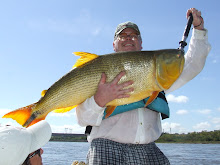
Peacock bass are not really a bass. They were named this to attract sportfishermen from around the world to battle these monsters. In reality, peacock bass are a member of the cichlid family.
Peacock bass are also known as pavon and tucunare. They are native to South America's Orinoco and Amazon River basins. They have recently been introduced into the Florida canals.
Peacock bass have blotches on side of its face and the speckled peacock has 3 distinct vertical bars on its body. The speckled peacocks are the largest of the peacocks attaining weights up to 30lbs. Most peacocks roam in gangs as they are somthing of a thug!
Peacocks have an "eye" on its tail to fool prey while attacking hence the name peacock similar to the bird!
Peacock Bass are known for top water explosions often tossing lures high into the air only to hit them again and again.
Peacock bass mouth brood their fry with the father attacking any enemy around the nest. The male peacock obtains a pronounced forehead of fatty tissue during sexual maturity.
They are very fast swimmers and can put a test to the best of fishermen with their rod breaking runs.
The IGFA recognizes 4 types of peacock bass, blackstrip peacocks or royal pavon which get up to 10lbs, the butterfly peacock which have 3 blotches on its body instead of bars. They are also found in Florida and reach weights up to 16lbs. The Orinoco peacock is easily confused with the butterfly peacock. The speckled peacock is the largest of the peacocks reaching weights to 30lbs.
Larry Larsen or http://www.peacockbassassociation.com/ has written 4 excellent books about peacock bass of which I highly recommend before heading to the jungle in search of giants.
I started my quest for peacocks on Lake Guri, Venezuela in 1990 and eventually found myself in the jungles of the Brazilian Amazon in a quest for these monsters! I highly recommend a trip into the jungle to battle these brutes.

No comments:
Post a Comment